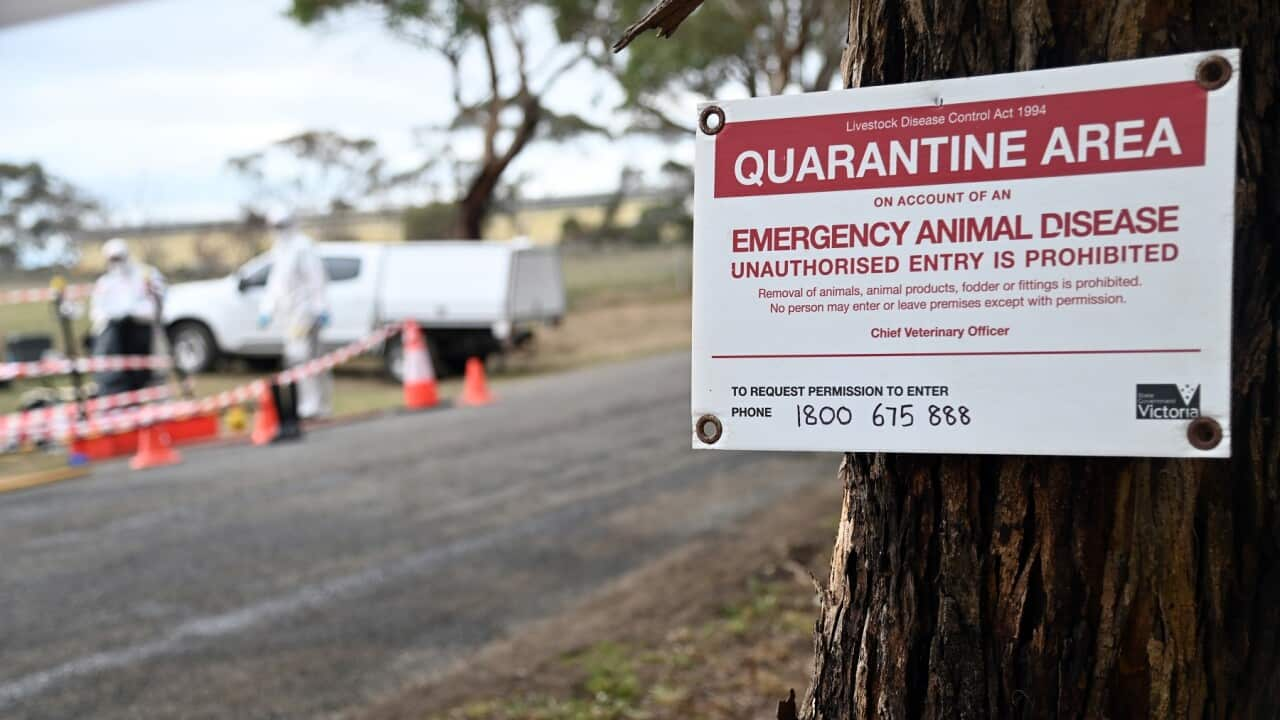TRANSCRIPT
Avian flu has Australia on edge as eggs are in short supply and outbreaks are spreading across Aussie farms.
The Australian Centre for Disease Preparedness or ACDP, has been at the forefront of testing and research on avian flu.
It has detected the H5N1 strain to Australia’s north and south, but not here in Australia.
But Dr Deborah Eagles says the government is preparing for its arrival here.
“So, both globally, and in Australia, avian flu is having a significant impact. Globally, the most significant strain is a H5 virus, and it's more specifically known this particular strain by scientists as H5N1 2.3.4.4B. This has now impacted all continents except for Australia, and that does include Antarctica and has caused deaths of poultry, wild birds, and a range of mammalian species. Both industry and government agencies in Australia across agriculture, health and environment are all preparing for the potential introduction of H5N1 one into Australia.”
Recent findings indicate that there are three distinct outbreaks occurring simultaneously in Australia, each caused by different strains of the virus.
Dr Eagles says, in Victoria, the highly pathogenic H7N3 strain of avian influenza has been confirmed, as well as other strains in other parts of Australia.
“Australia has responded to an unprecedented three outbreaks of highly pathic avian influenza of other strains, and this is all since late May. So Australia has had avian influenza outbreaks in poultry previously with eight outbreaks of H7 highly pathogenic avian influenza since 1976. Prior to this year's outbreaks this year, ACDP has conducted 3,000 tests on a thousand samples since the first detection of H7N3 near Meredith in Victoria in May, and subsequently in H7 and H9 in Terang in Victoria, H7 and eight in New South Wales and ACT. And we've provided a central confirmation of highly pathogenic avian influenza on each of the infected properties in Victoria, new South Wales, and ACT.”
So, how exactly can scientists tell the difference between these strains and the separate outbreaks?
It all comes down to genetic sequencing.
By analysing the RNA of the virus, researchers can identify unique markers that differentiate one strain from another.
This allows them to trace the virus's evolution and understand how it spreads.
The ACDP uses state-of-the-art technology to perform these analyses, providing critical data for managing the outbreaks.
Dr Frank Wong is Senior Research Scientist at the A-D-C-P.
“So the key thing is Avian influenza viruses are named according to the nature of the proteins on the virus surface. So that's how we refer to H-5-N-1 strains or H7N3, H7N8N and so on. So the surface proteins on influenza viruses, they act very similarly to what we might be more familiar with. We've all heard about the spike protein on the covid virus. So influenza virus have similar proteins on their surfaces.”
The origins of the current bird flu outbreak lie in 1996, when a type of influenza A known as H5N1 emerged in southeast Asia.
Australia has historically been protected from highly pathogenic avian flu because it’s spread by migrating ducks, geese, and swans from Asia.
However, birds from Asia that encounter infected migratory birds could bring the virus to Australia.
“So what about in the wild, such as ducks and geese, are the natural host reservoir for all avian influenza viruses where they mostly exist as low pathogenic viruses causing no signs of disease. So when viruses, particularly of the H5 and H7 strains occasionally get introduced from wild birds into large populations of farm chickens, highly pathogenic avian influenza may merge due to virus mutation leading to the devastating H7 outbreaks, for example, that we have recently seen in Victoria, New South Wales and ACT.”
The ACDP plays a crucial global role in monitoring and surveillance here and around the world.
As a leading research institution, the ACDP collaborates with international organisations to share data and insights on avian flu.
Dr Wong says this cooperation helps track the global spread of the virus and develop strategies to mitigate its impact.
“So this program undertakes active, what we call peace time, Avian influenza virus surveillance in wild bird's samples collected in each Australian state and territory, meaning that this surveillance happens in absence of any obvious signs of disease. And this is important because it allows us to gather the baseline data on viruses that we know within Australian wild birds. So hundreds of bird flu samples collected by this program are analysed here at ACDP allow us to perform what we call genomic surveillance, which provides invaluable information on what virus strains are already in Australia, which highlights the importance of this type of active surveillance program. Effective avian influenza surveillance in wild birds can also provide important early warning of any new viruses that could be carried into Australia.”
The ACDP's work not only protects Australian farms but also contributes to global efforts to control avian flu.













